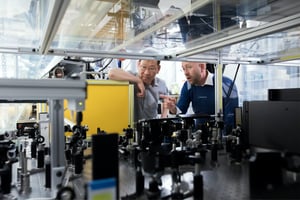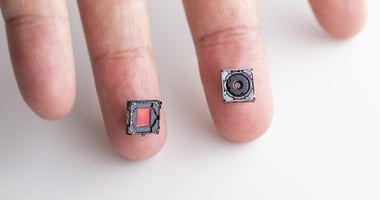Manufacturing Day (“Mfg Day”) is held each year on the first Friday in October, but events...
COVID-19 Pandemic Reinforces the Need for More Scientists and Engineers More than Ever
In a world where social media and political agendas make it hard to discern fact from opinion, there has never been a more pressing need for trained scientists and engineers. The current health crisis underscores the importance of rational decision-making based on data, sound analysis, and evidence from application of the scientific method. The simple truth is that reason leads to better outcomes, especially in emotionally-charged and politically divisive situations where the consequences of a poor decision are far-reaching.
Unfortunately, there is a shortage of scientists and engineers in the U.S. There are several reasons for this. One is the declining number of foreign-born workers who, in recent years, have staffed 20-25% of the American STEM (science, technology, engineering, and math) workforce. The decline of 17% among this cohort, according to the American Immigration Council, is due to changes in immigration regulations and a slow-down in employer H-1B visa sponsorship for foreign workers. Companies looking for STEM talent have to rely on domestic talent, which provides a far smaller pool of qualified workers. Another reason is the impending retirement of 27% of STEM workers in the next decade. The Society for Human Resource Management reports that many companies lack sufficient succession planning and knowledge transfer strategies to address the issue.
Compounding the problem is a lack of interest in STEM education. In fact, the number of teen-aged boys interested in a STEM education dropped from 36% in 2018 to 24% in 2019. The interest level of teen-aged girls remained stagnant at 11%. Though the number of female college graduates in STEM programs has increased to 24% in that period, males continue to vastly outnumber female graduates in the STEM workforce, which is 71% male. Parental influence is another contributing factor. Only three in ten parents advise their children to consider STEM careers, possibly because of an unfavorable perception of the industry. In fact, a recent survey found that less than half of respondents believe that manufacturing jobs are interesting, rewarding, clean, safe, stable, and secure. Other studies show that girls need more role models. They are more interested in hands-on experience, and want to see the “life applications” of what they are learning. Role models could boost young girls’ interest in STEM.
Some may suggest that the seriousness of the shortage is exaggerated because automation and machine learning can “pick up the slack” and, thus, overcome the skilled manufacturing talent shortage. That may be true to a degree, but in a recent Harvard Business Review article, H. James Wilson, Managing Director of Information Technology and Business Research at Accenture Research, and Paul R. Daugherty, Accenture’s Chief Technology and Innovation Officer, stress that “Humans need to perform three crucial roles. They must train machines to perform certain tasks; explain the outcomes of those tasks, especially when the results are counterintuitive or controversial; and sustain the responsible use of machines (by, for example, preventing robots from harming humans).” Humans exhibit the leadership, teamwork, creativity, and social skills, and machines the speed, scalability, and quantitative capabilities. Business requires both, and so does decision-making.
What scientists and engineers bring to the table is a methodology and a disciplined approach to solving problems. This is not to say that intuition and emotion do not play a part. They enable decision-makers to choose a solution when interests and options conflict, and to see the emotional aspects in situations, as well as the impact to others. Emotions and intuition are internal barometers that allow leaders to consider aspects of a problem that otherwise may have been overlooked. However, there must be a filter. Decision-makers should consider whether the emotion results from intuition and experience, or is based on how others might respond. Often, a purposeful delay in making a decision gives pause for one to reflect. Colleagues can be helpful in providing feedback on emotional triggers to discern when best to follow one’s instincts or ignore them. It is important to note that emotions include more than “feelings” of anger, worry, etc. They include social norms such as fairness, equality, and magnanimity, too. With a broader perspective on emotions, it is easier to understand that even the most hard-core proponents of the scientific method still incorporate intuition and emotions in decision-making. There is a balance.
Problems occur when emotions overtake rationality and disrupt the balance. The COVID-19 pandemic is a stark case in point. Political wrangling between the Democrats and Republicans, the impending Presidential election, differing opinions about the safety, necessity, and/or timing of reopening businesses, economic damage to the U.S. economy, concern over Constitutional rights violations, and our society’s propensity toward conspiracy theories, among others, have caused some decisions to be made mostly on an emotional level, and others to be made based on a misinterpretation of the data. In the midst of all of this, it has been the medical experts and scientists who continually reminded politicians to rely on the science and the data as presented and interpreted by experts.
The need for immediate answers in the face of severe public health and economic distress creates a temptation to relax statistical standards. Urgency, though, should not preclude expert analysis and honest assessments of uncertainty. Mistaken assumptions are counterproductive and could lead to significant negative consequences. An article published by six Rand Corporation researchers cautions analysts, journalists, and policymakers that:
- Comparisons of raw data can be misleading.
- Measurement error resulting from different levels of testing, accuracy, and transparency of reporting and case numbers can impact observed differences;
- The degree of public compliance can bias conclusions;
- Overlapping responses can complicate the analysis;
- Sound analysis requires consideration of public reaction to pandemic needs;
- Neglecting to report uncertainty undermines the public debate; and policy should focus on interventions that have strong underlying scientific merit.
Readers who are interested in specific examples of misinterpretations of data around the COVID-19 pandemic can access this article.
This pandemic underscores the reason why STEM professionals are essential in modern society. Their expertise and experience can guide leaders, government policy-makers, and people, generally, to more sound, rational conclusions and actions. We should look for ways to encourage more students to pursue a STEM education.



